Milkweed pods are edible, and one of the most delicious wild vegetables available to foragers. With their shape and small size, I like to call them wild okra. In this post I'll tell you everything I know about them.
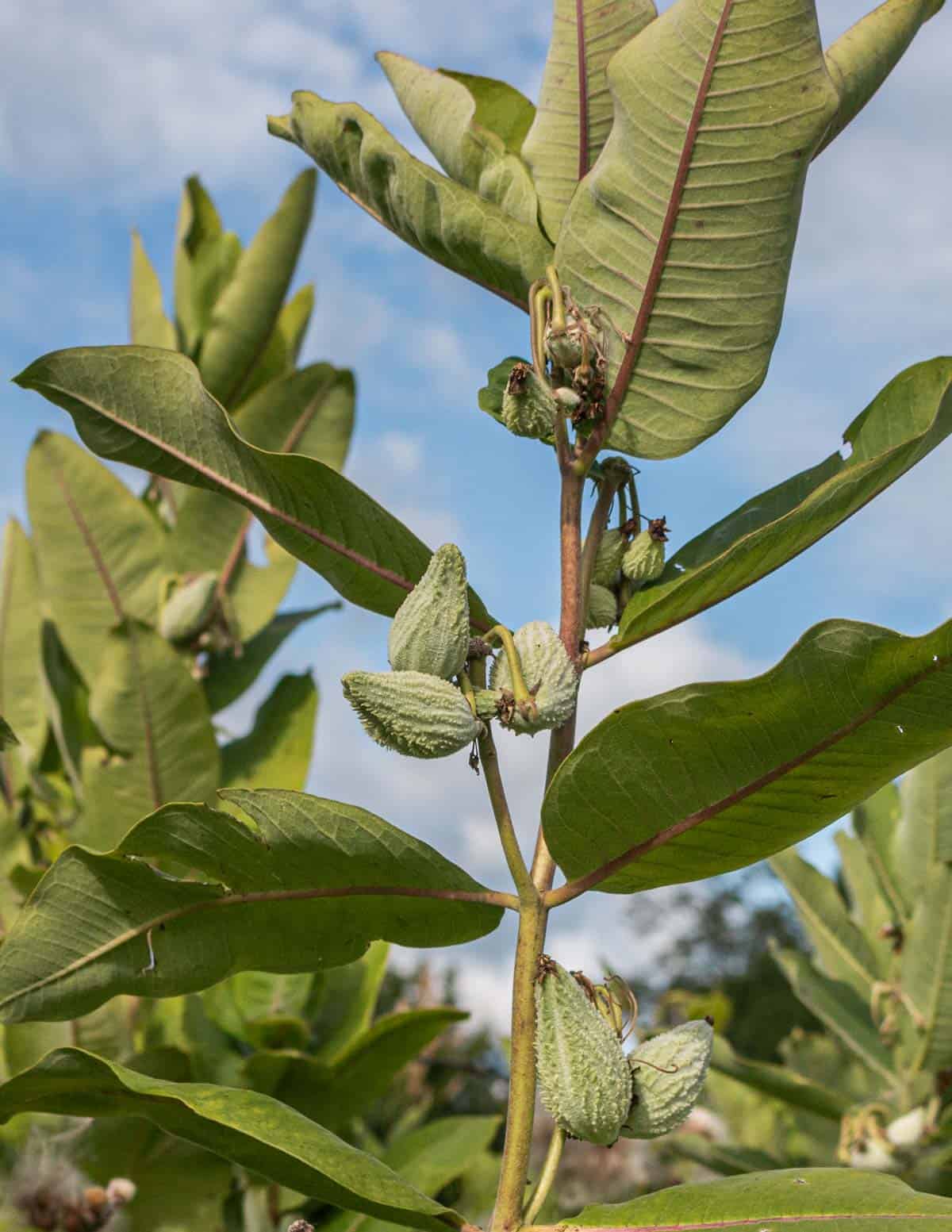
Note: This post only covers harvesting and cooking the edible pods of milkweed. For a full breakdown of every edible part of the plant I know, please refer to my Guide to Milkweed.
A Truly Wild Vegetable
There's lots of wild plants out there, but it's rare to find a plant that produces something similar to what you might cook like a garden "vegetable". Milkweed pods are one of the anomalies, over a season it has 3 different parts than more or less resemble unique little vegetables.
After the young shoots and buds form in the Spring and early Summer the pods are the last of the milkweed vegetables to enjoy in late summer, they're not to be missed.
There was a big learning curve for me in between the time I found out milkweed pods could be eaten and my understanding of how to forage, cook, and most importantly, enjoy them. With shoots and flower buds prep is pretty straightforward: toss them in a hot pan, apply seasoning and eat.
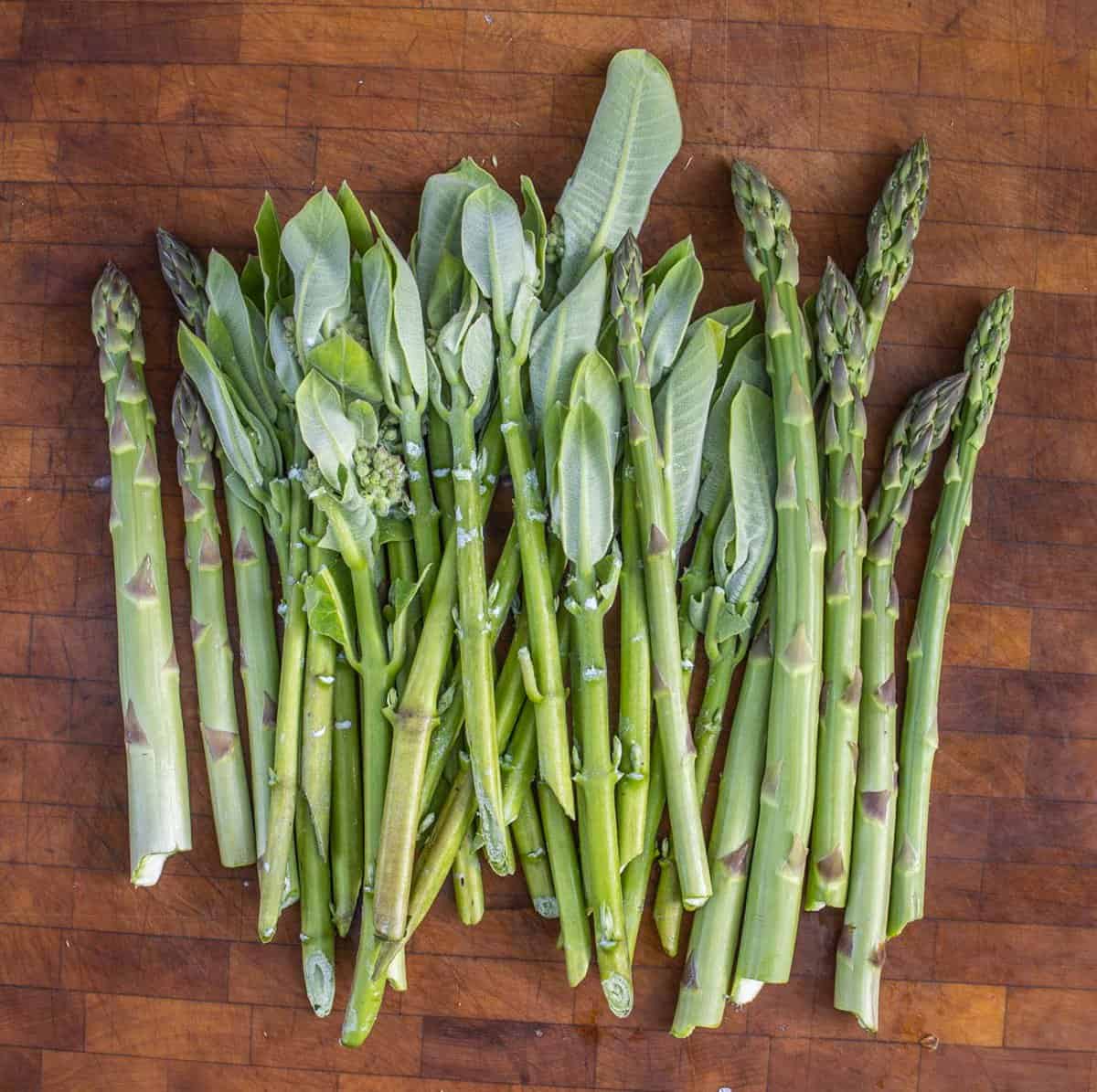
The pods require the most technique by far, and for a couple of years confused me to the point where I thought there was no way people were actually eating these things, all of the pods I had were tough, stringy, or full of seeds. As you might expect, I was wrong.
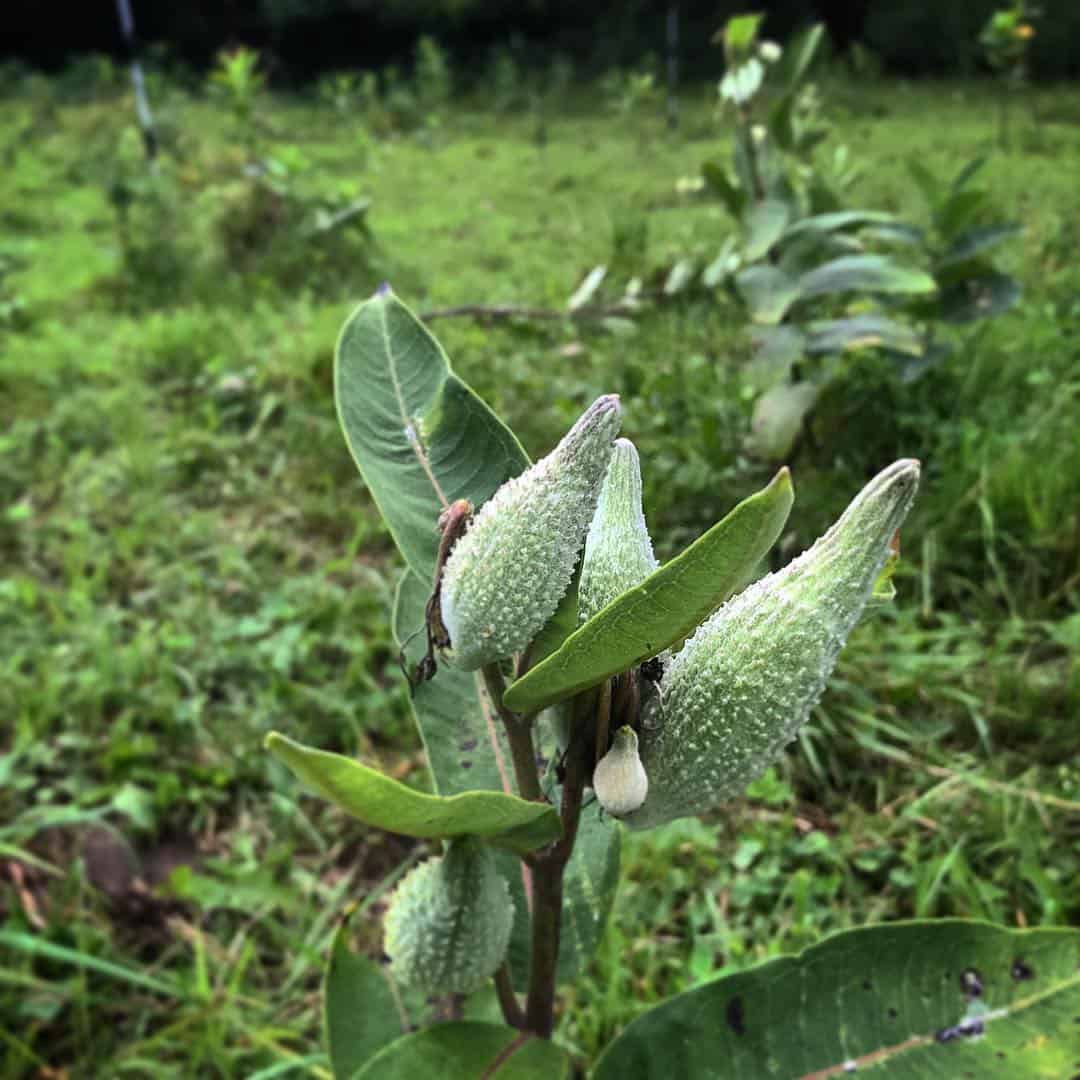
How to pick pods you can eat
This is the most important thing to know, but the most complicated to comprehend, is when to collect milkweed pods. If you read a guide that actually talks about eating milkweed (most don't except for Sam) there's likely to be a sentence to the tune of: "young pods need to be 1-2" long to eat". This isn't a casual request, it's the difference between enjoying eating something, and ingesting something. Eating should be fun, ingesting is just like it sounds.
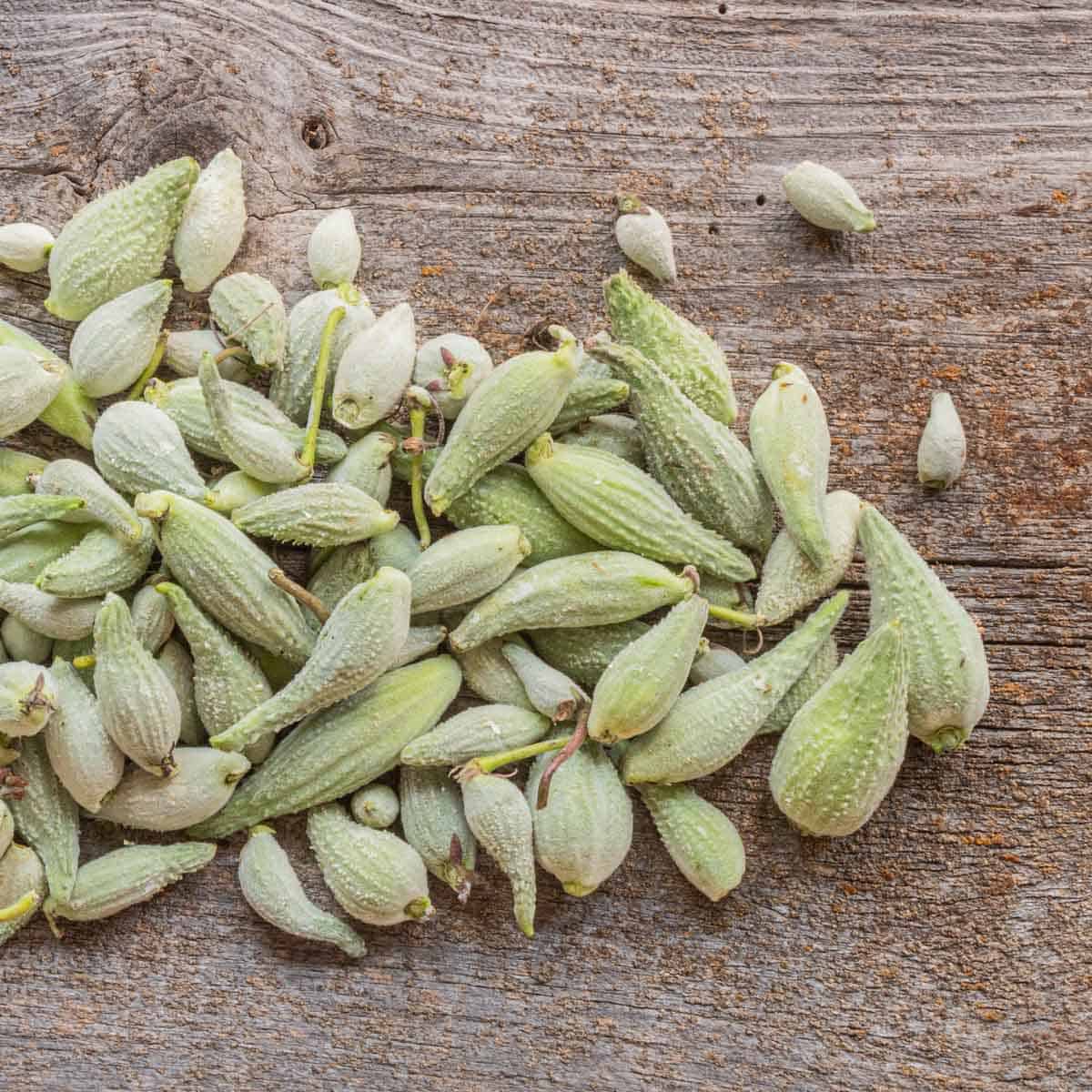
The pods on a milkweed plant mature at slightly different rates, it's not like something along the lines of lamb's quarter or say asparagus. Just because there's pods on a plant doesn't mean it should be eaten. Resist the temptation to pick all the pods except the ones that are very small, as much for the fact that they taste better as that it's not good to pick all of anything, except morels.
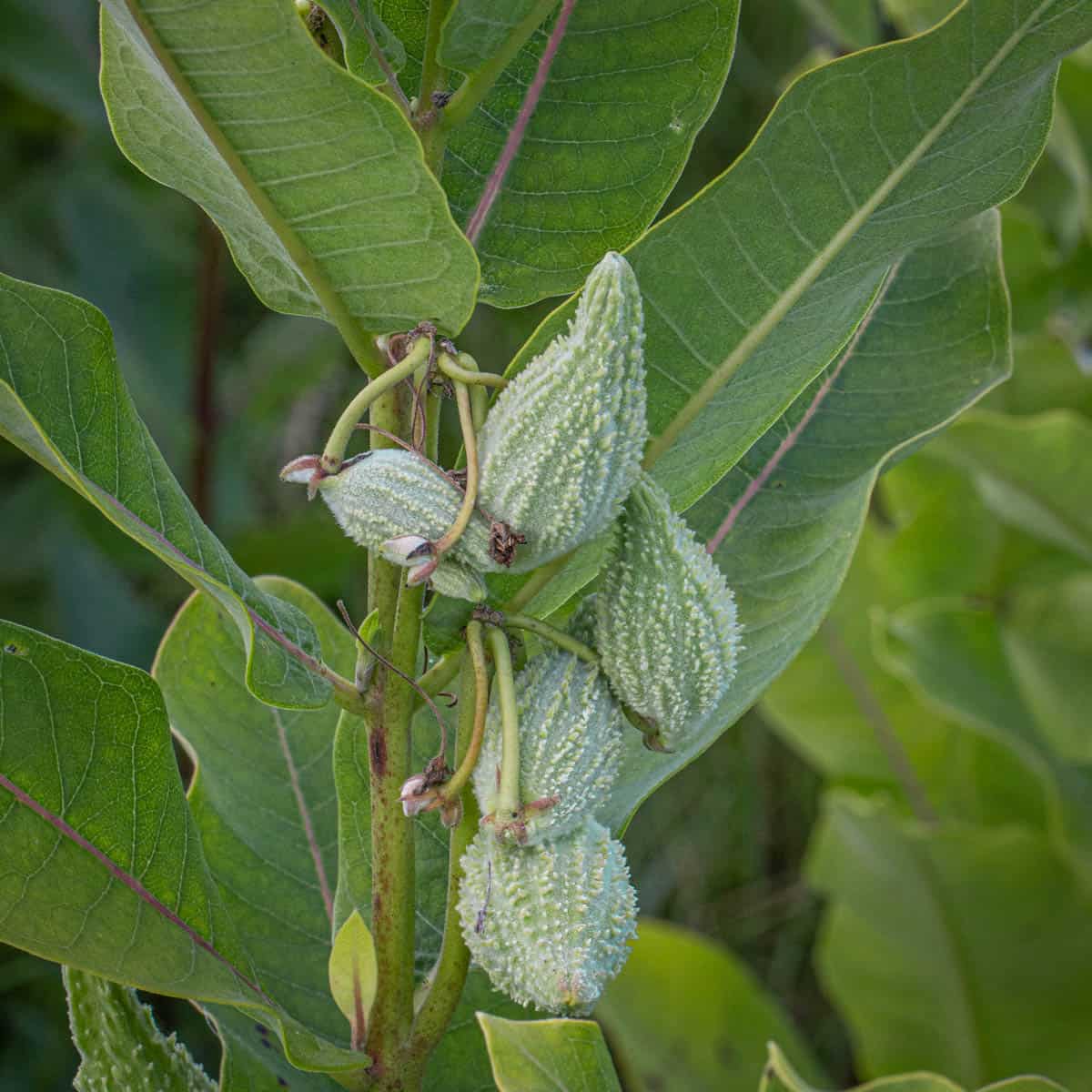
Here's a few tips/excercises:
1. Don't pick pods that have a slit that opens easily, they should resist opening.
2. All pods should have a soft, pure white interior, the seed/silk inside shouldn't show any signs of color.
3. The pods should not be noticeably soft, they should be firm, a bit like okra.
4. Older pods may have pronounced "spines".
5. Find pods of different sizes and ages, then bite them. You'll quickly learn about which are tender and which are stringy.
6. Don't be afraid to pick very small pods, they're excellent.
What's inside the pods?
That's milkweed silk, or immature seeds, and it begs the question: "what constitutes a vegetable", it's edible, and has a fine flavor, but should be be mixed other ingredients to form a dish. My friend Sam likes to call it milkweed "white".
The useful part about it from my perspective is that milkweed silk is often at an edible stage when the outer green shell has become too stringy to enjoy, so even if you're a little late to the party at the milkweed patch, it doesn't mean you have to go home empty handed, just crack open the pods to make sure the seeds don't have any color to them yet, they should be perfectly white. I have gone out just to collect the silk sometimes.
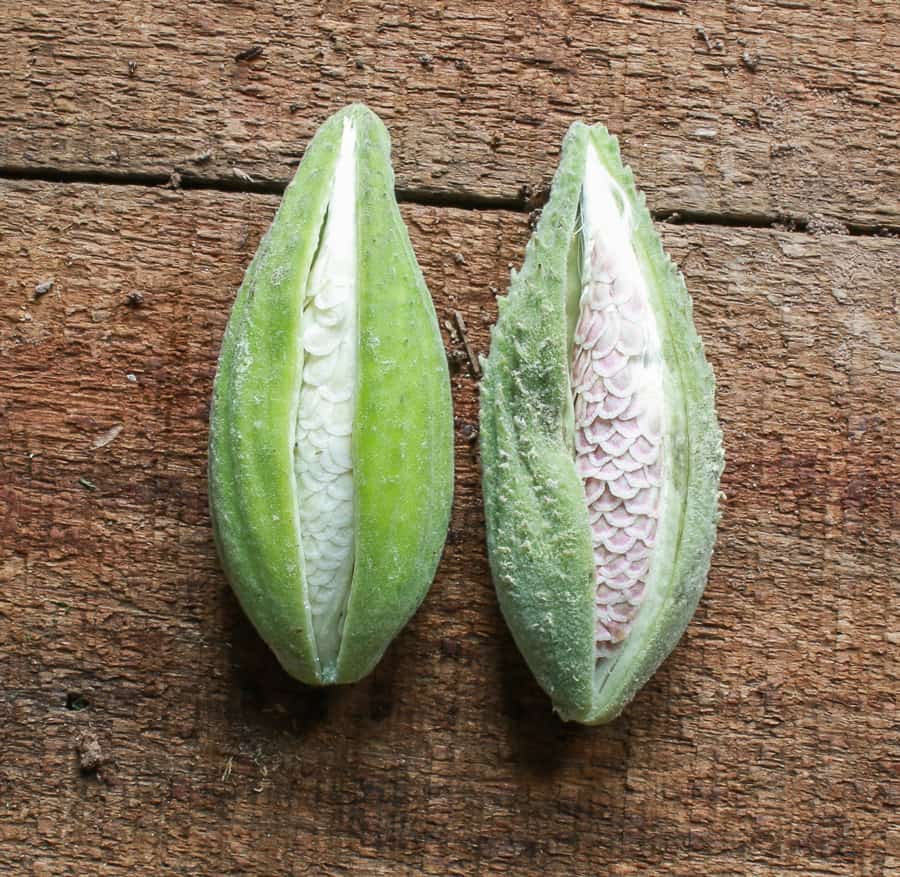
The silk has a softness to it almost like a sort of cheese, and it follows that it makes a funky cheese substitute, or fun gratin style dish or baked dip mixed with cheese and a few other mild things (I like cooked onions and a pinch of garlic, or sour cream, mayonnaise and hot chili).
Unlike cheese, the milkweed silk will not completely melt, and depending on the stage of development of the seeds, it may be a little more chewy or textural depending on how far along the development of the seeds is. For more, see my post on Milkweed Silk.
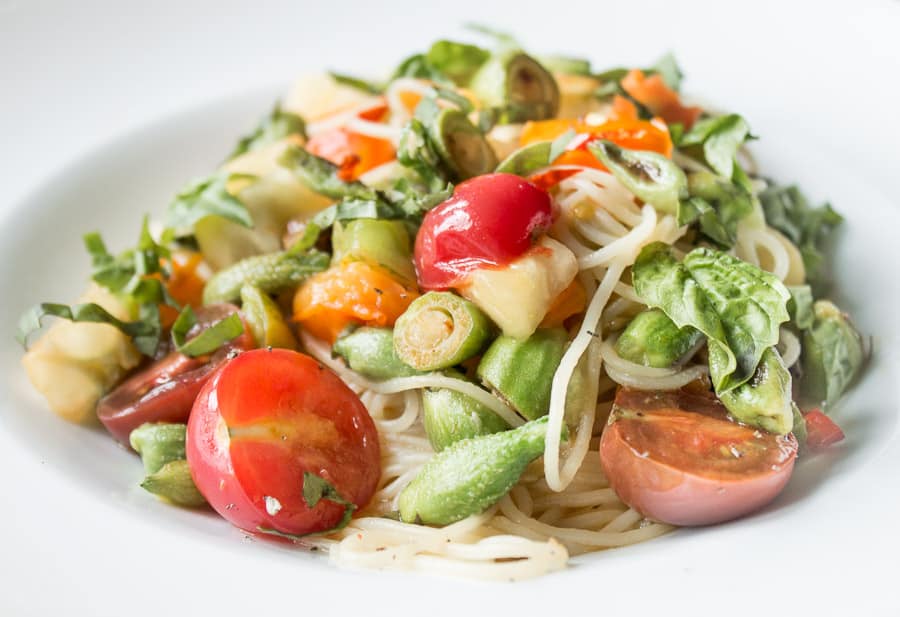
Harvesting, Cooking and Storage
Harvesting
I have an organic cow pasture where I pick mine, but a decent open space should do, just resist from picking them on busy roadsides. Sometimes I'll pick them on country roads that are seldom used, but this can mean you have to rinse things carefully for sand as those roads are generally gravel. I twist the youngest pods off with my fingers, and leave older pods on the plant to grow and feed other creatures.
I store the pods in paper bags with damp cloths, or in plastic bags lined with cloths with some holes sliced in it to allow air flow. I have had milkweed pods last for over a month at a time at a restaurant cooler with proper storage.
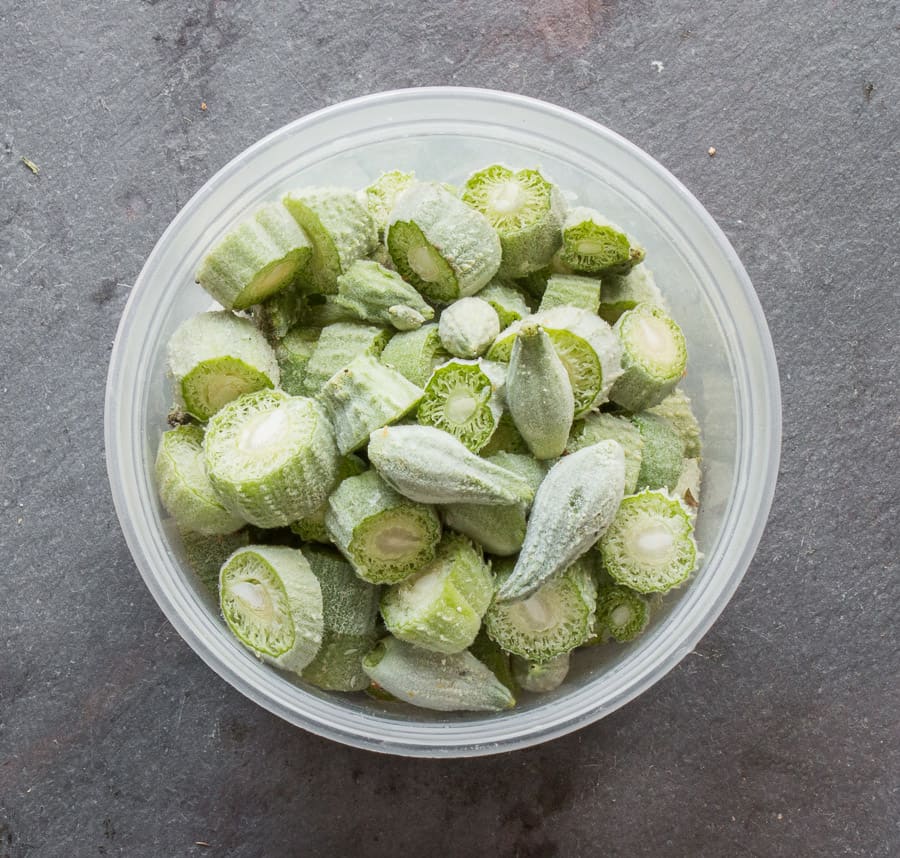
General cooking
For the most part when I want to cook the pods I just throw them in a hot pan and cook, most of the time I like to use a wet preparation, especially with tomatoes. Milkweed pods have a bit of a spongy texture, so I like to use a minimal amount of oil when cooking them. Using a large amount of oil, or frying them up with other starchy vegetables like potatoes could make them sit in your stomach like a lead brick.
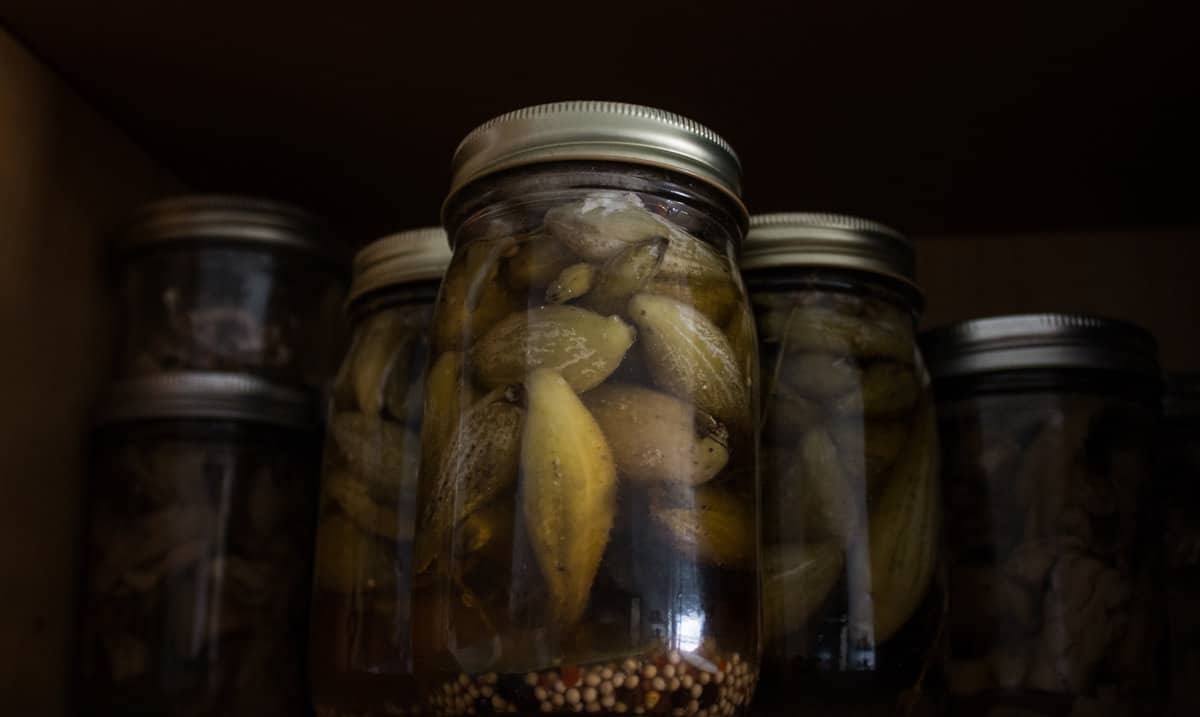
The okra similarity
I alluded to them tasting like okra earlier for a reason. Okra and milkweed share a lot of similarities, the only one they really don't share compositionally is the mucilagenous thickening quality that okra has. Besides the mucilage, they're pretty much interchangeable, bread and fry them, saute, braise, bake in a juicy casserole, or better yet fry or pickle them, just like okra.
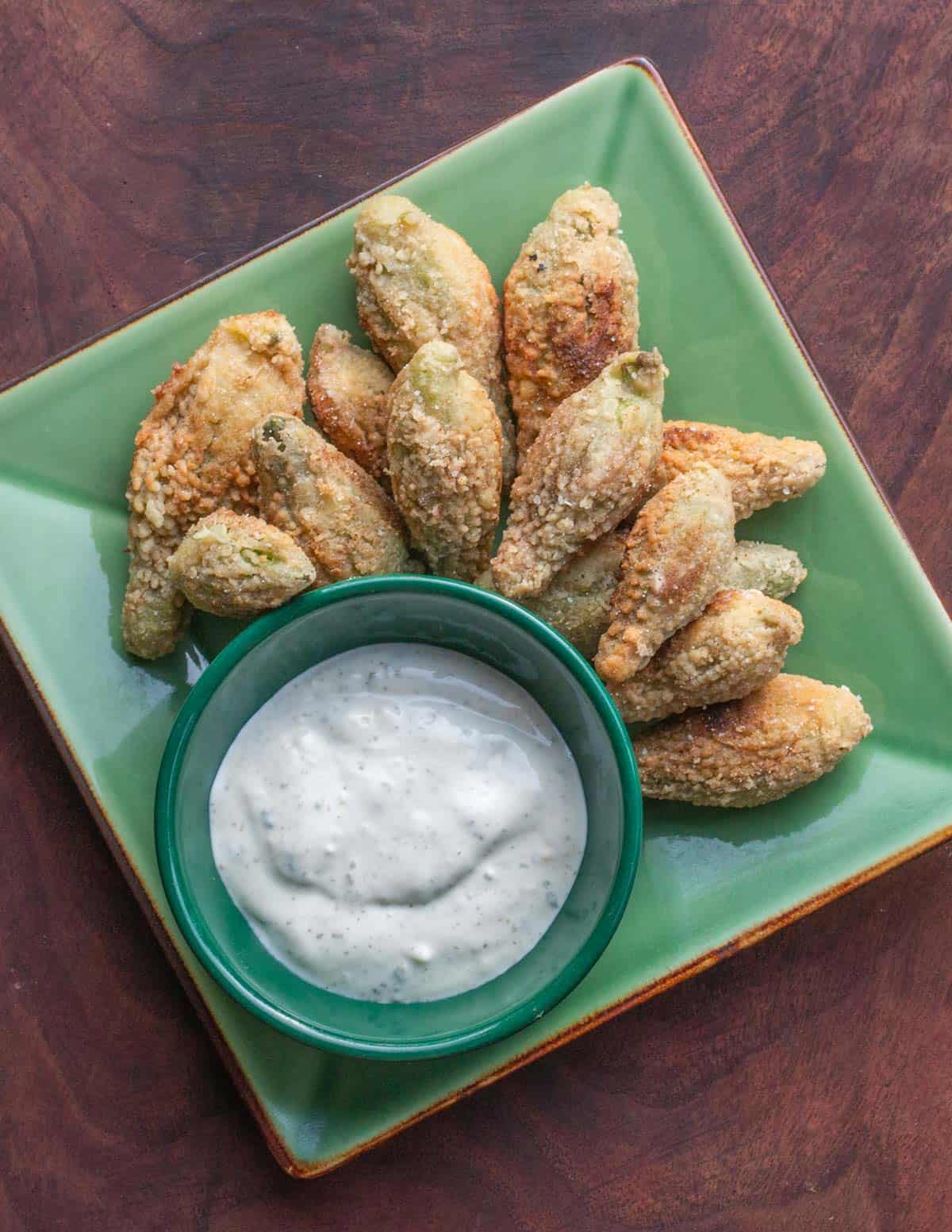
They have a lot of flavor friends like I mention above, substituting them for okra or places where it could be used is a good start. They love the vegetables and flavors of summer, fresh, bright herbs, tomatoes, and Mediterranean style recipes, but that could just be my European training talking, milkweed curry is bound to be great too.
Whatever you do, don't make it too complicated or heavy, keep it light (don't reach for that cream) so you can taste the flavor, it's green, delicate, it tastes like Summer.
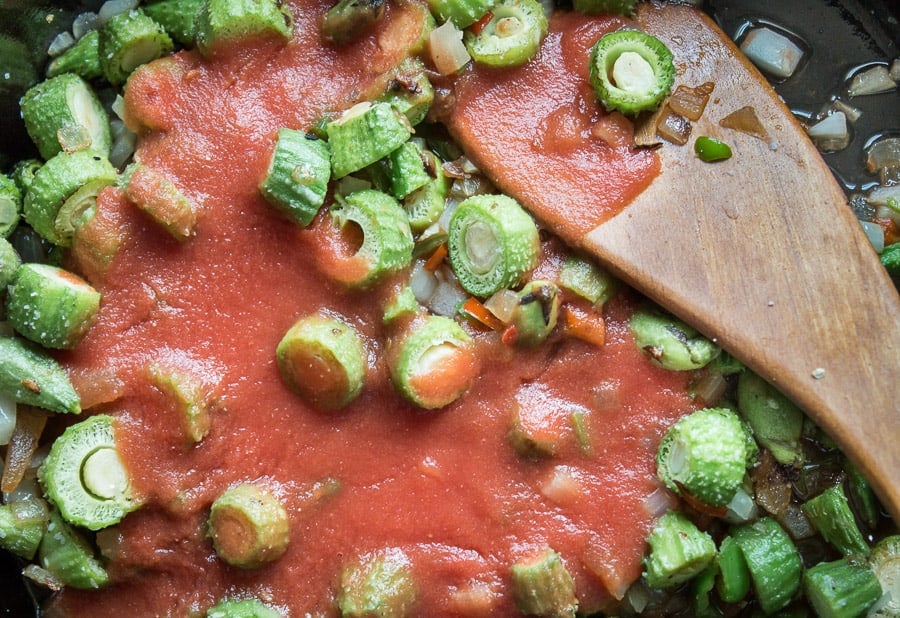
Do you need to boil / blanch them?
I don't, but if it's your first time trying them, you definitely should, as some people are apparently more sensitive to milkweed than others. Either way, make sure to cook them through, and don't eat pounds of them (or anything) in a single sitting. If it's your first time eating milkweed pods, blanch them in boiling salted water for a minute or two first and consume no more than 2 ounces.
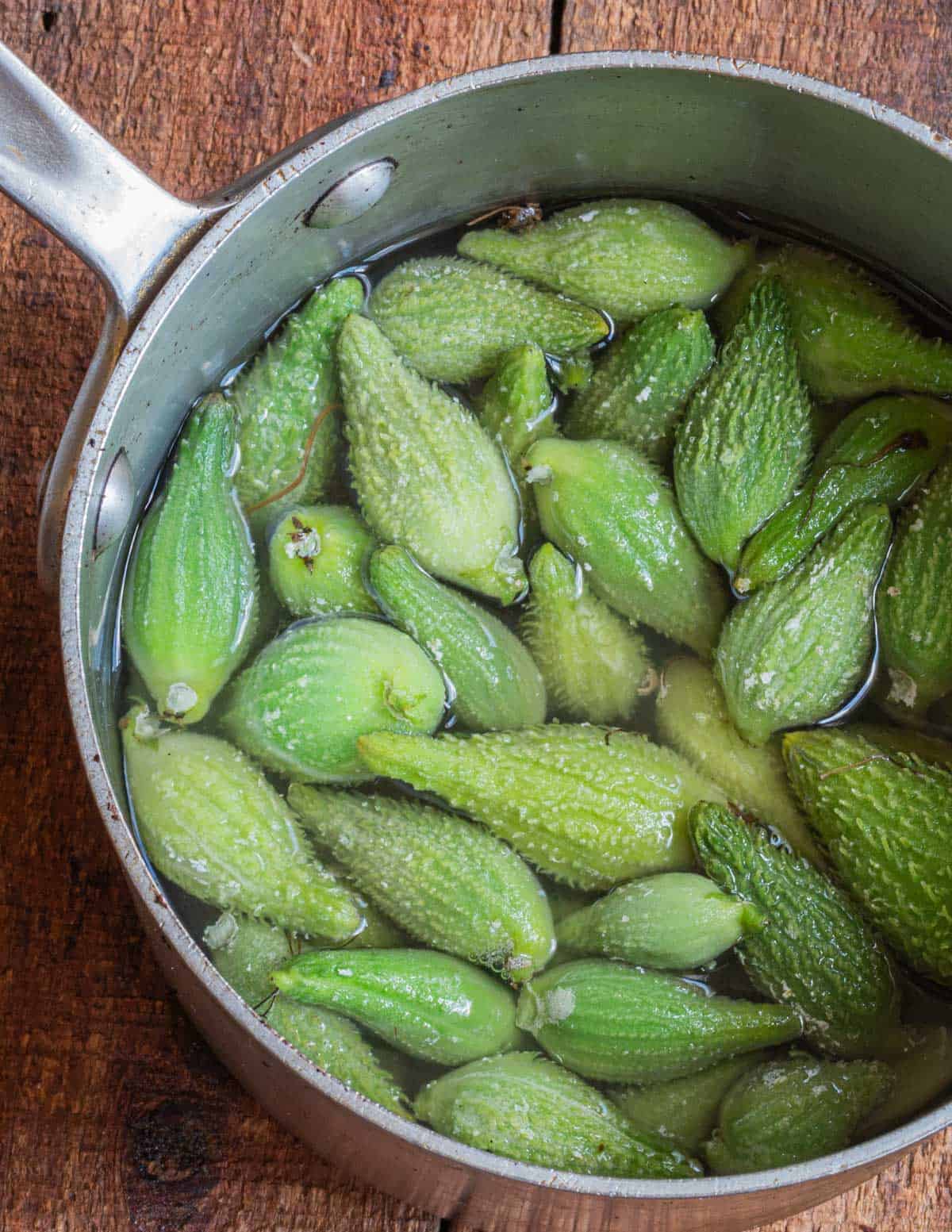
When serving them, it's also good to give people who haven't had them before small amounts at first to test for allergies. Even if people aren't "allergic", I've heard of gastro-intestinal distress from over-eating other parts of the plant, but remember some people get tummy aches from milk too. Moderation, in all things, including milkweed.
Are they good to stuff?
No. But I understand why people want to. Most food that has a natural cavity (morels for example) make great stuffing candidates. The problem with the milkweed pods is that by the time they're big enough to stuff, the outer skin is too tough.
Don't feel bad though, with the lack of resources and information for cooking with these, it's easy to make mistakes, I have too. To me, stuffing them involves removing the inner, undeveloped silk, which is part of the plant and perfectly edible as it is. Removing it, when the plant could be just thrown in a pan and cooked as is, to me, is over-complicating things.
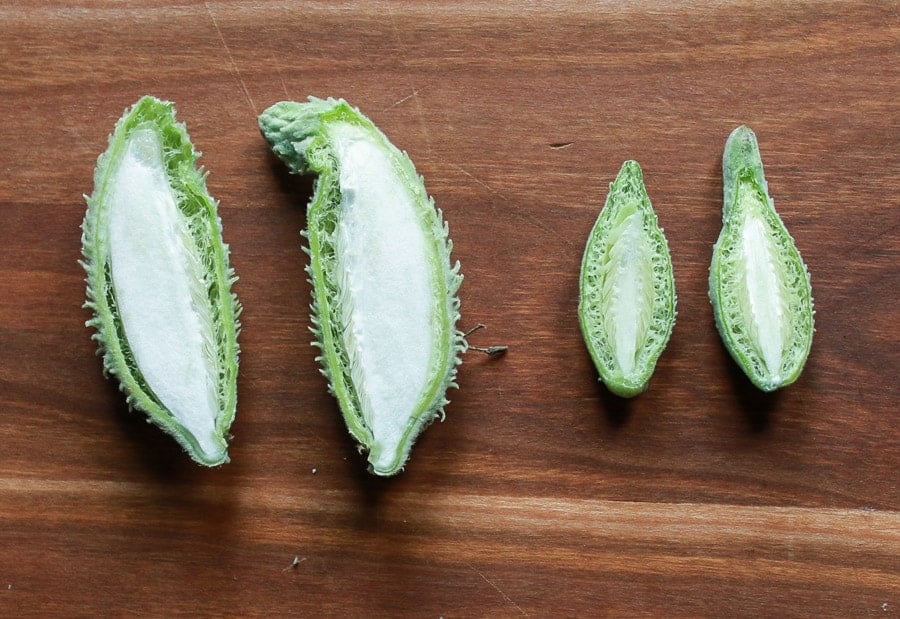
A number of years ago I was cooking a wild food dinner at a restaurant with a James Beard Award-nominated chef. The chef had fried, foie gras stuffed milkweed pods on one of the courses for our dinner.
I suspected they would be picking the biggest, fattest pods possible and unfortunately I was right. Every single plate I saw come back had only nibbles out of the costly stuffed pods the chef was so proud of, and had wasted so much expensive foie on. Once the guests discovered the sinewy, tough strands in the pods skin were about as edible as plastic tie handcuffs, they didn't bother to touch them and I wouldn't have either.

Megan
I love all your recipes! I just scored some pods and I can't wait to try them!
Alan Bergo
Thanks Megan. Remember to blanch them and have just a few if it’s your first time to make sure they agree with you.
Jaci
I finally tried milkweed pods. I took your advice and started small: just four pods that I boiled. Ate two and loved them. Decided that was enough for now (just a sample) and, boy, am I thankful I did. Guess who is allergic to milkweed pods? But they were delicious!
Alan Bergo
Yep. Unfortunately some people just can’t tolerate them. Same with cattails and day lilies.
Jen Sharples
This is my first time to your site and I'm enjoying it. Yesterday I was walking through a conservation area near my house and I discovered the Milkweed plant (I had no idea what it was and had to Google it, eventually landing here). The pods I saw were already grown and opened. Some of the white silk was hanging out of it. So, maybe someday I will be able to grab a few smaller ones to try. I am, however, an avid tea drinker. What parts of the plant would I be able to steep in a tea?
Alan Bergo
You can dry the flowers for tea, or use them fresh, which is even better.
Jen Sharples
Awesome! Thank you so much 🙂
Alex
Do you know, are honeyvine milkweed pods interchangeable here? Those are the kind I have growing.
Alan Bergo
Not to my knowledge.
George
Thanks for doing some mythbusting with this traditional food. Man people are crazy about it. We have a yard full of pollinator plants and we eat the milkweed in the summer. People need to understand if they plant more milkweed, there's more food for everyone to go around.
Ed
Do you think they can be frozen after blanching to use later, or would that affect the texture or flavor?
Darren
How are they to somebody like myself being lactose intolerant
Alan Bergo
They don't come from a cow, so they should be fine.
Mike L
I love this info. I have never tried the pods but certainly will. I have previously enjoyed the shoots and young buds and found them exceptional. I had been taught to boil in two changes of water (Wildman, Steve Brill). When taking the shoots, I found that new shoots would follow and always left buds on the plant. There seems to be plenty for humans and animals to enjoy in harmony. I found that placing the cuttings immediately in water prevents the latex from skinning over and remaining through boiling, otherwise I do find a slight irritation in my throat. The flavor is well worth it.
Janet
Your writing would benefit from attention to subject-verb agreement (such as "are" when the noun is plural). Also, look up the meaning of 'begs the question" and probably just don't use it again (it's complicated)..
Alan Bergo
Cool story, I'll get right on that.
Carol Drury
Good grief. With all the problems in this world, she worries about grammar?
Alan Bergo
Complaining is an American past time. 🙂
WhatNo
I can’t believe you’re encouraging this while Monsanto, loss of habitat and extreme weather are sending monarch pollinators to extinction. It’s not like the options aren’t out there.
😑
Alan Bergo
I'll work on some new milkweed pod recipes this year for you. "The Karen Special" has a ring to it.
Screw you
Wow. Your snotty, rude, flippant attitude and downplaying the risks of eating this are really offputting. What a Kyle.
Alan Bergo
Who hurt you?
keith smith
damn, that's funny
Mary Cathyrn Olsen
Thank you for the information. What is the food value of milkweed pods?
Alan Bergo
I can't speak to the food value.
WhatNo
Hum. You have no actual value you know or can list for eating it? (Ignore the poison!)
Reminds me of all the wealthy who have to eat endangered species because somewhere in their muddled minds, it makes them the apex predator and that’s a good thing , amiright?! 😒
Hannah
As it is, we often don't know what is really in our food most of the time because food companies limit our access to such information. Animals themselves don't think about the nutritional value of what they are eating; they see something that appears edible, they consume it. Not having an idea of what the nutritious value of some food item is, without question, something every living thing on the planet has done.
Source: current biology major.
Hannah
Today I Found a bunch growing near my house and wondered what to do with them. Thanks for the info!
Gerald Le Gal
Milkweed products do contain cardiac glycosides and poisonings are a common affair. Check this out with your government anti-poison centre. The white latex that the plant contains is considered toxic Happily enough, this latex is also soluble in water. All milkweed product (young shots, flowerbeds and pods should be washed vigorously in water, then stored in a covered container filled with water in the refrigerator for at least 24 hours. The pods or other products are then drained and boiled for 3 minutes and water-cooled immediately to stop cooking. They are then ready for use
At Gourmet Sauvage, we have been preparing these vegetables commercially since 1993. Our process has been lab-tested and confirmed. Without prior preparation, you are waiting for an accident to happen, regardless of what Sam says.
Alan Bergo
Thanks for adding your two cents. Some people react to milkweed not being boiled, some do. Some react to overeating. I can eat them with impunity. As the texture and flavor are superior without blanching, I don't blanch mine, but it is exactly the reason I suggest people should proceed with caution if they want to sample them without par-boiling. Suggesting they be soaked in a container full of water for 24 hours, and then blanched after that is overkill in my opinion, but if it works for a commercial operation to prevent you getting sued, that's useful. Boiling milkweed buds specifically saturates them with water, making them a far cry from the fresh specimens I prefer steamed. Obviously everyone cant enjoy them like that, but I will not endorse blanket statements that can decrease the joy of eating them as I've done for a long time now. Serving them to the general public is a different matter though. Also, if you haven't tried dehydrating the young buds, you should try that too, they re hydrate very well.
Butter
Why the extra step of the refrigerator soak? I've not heard this previously.
Sheila Oranch
Are milkweeds in the same family of solenoids as tomatoes and peppers?
Alan Bergo
If you're speaking of the Solanaceae family of nightshades, no.
Dawn
What recipe would you recommend for pickling milkweed pods?
Alan Bergo
Use a savory recipe, no sugar.
Jeff Parks
wow i can hardly wait to try these, heard about a gent in the Ottawa Valley who cooks them and I have a splendid yard full for the Monarchs, so why shouldn't an old 'queen' like me have a feast as well. thanks for the tips and your candid writing, a pleasure to read and a joy to follow.
Jeff P
Alan Bergo
Thanks Jeff. Yes, the monarchs generally eat the leaves too. Those of us that harvest milkweed as a food plant will be the ones helping to ensure the monarchs have plenty of food. It's a win-win.
Jeff
Milkweed sap has cardiac glycosides. How do you prevent poisoning?
Alan Bergo
Good question. Here's my opinion.
First, I would consider the source of your CG info. Is it true that all milkweed species contain the compounds, or if common milkweed (A. syriaca), which has rich documentation as a food plant by indigenous peoples, is getting unfairly lumped in with other milkweeds that are definitely dangerous to eat? A parallel could be when ostrich ferns get blamed for bracken fern poisoning, simply because people don't know the exact species of fern they ate, which is relatively common. That being said, some people have a milkweed intolerance, especially for high doses of the plant matter, especially if it isn't thoroughly cooked. With some things like this, documentation of indigenous uses and consumption of the plants can be more clarifying that information online, which, when referring to "weeds", can often be influenced by skewed opinions of the agriculture industry.
I would also refer to Foragers Harvest by Sam Thayer, his first book covers milkweed in detail.
emmalene
i have milkweed that grows next the my front porch. ???? my mom brought to my attention that they're edible, so now I'm trying them!
Alan Bergo
That's great, enjoy your pods. They can be some really good eating.
Melissa Christopher
Hi, Love your suggestions, recipes and ideas. Wondering if you could tell me which Asclepius you are using pods from. I have many and I would love to try this. Thanks, Melissa
Alan Bergo
Always and only syriaca/common milkweed. This is the only milkweed I know to eat.
Joy
Here in the Columbia Gorge, bordering Washington and Oregon, we have Asclepias fascicularis. I have been enjoying its buds, flowers, and pods for the past two years and have not experienced any digestive issues, nor have my dinner guests. I always follow the rule of MODERATION if it is the first time trying something. Also, do some of your own research, dont be a sheep.
Truely love what your sharing, thank you!
Alan Bergo
Thank you so much for sharing! It’s rare to hear about other species of milkweed being eaten. I’m going to make a note of this and see if I can find others that have eaten it. Either way I’m going to make a note of it in my posts and larger guide.